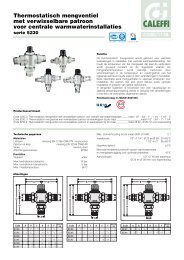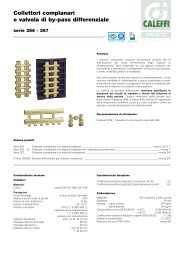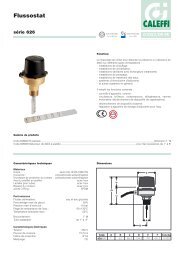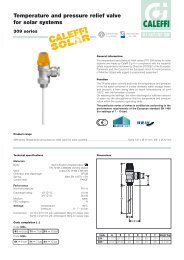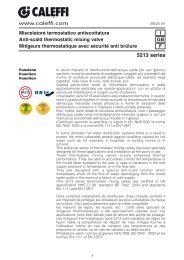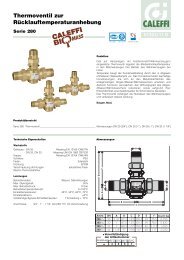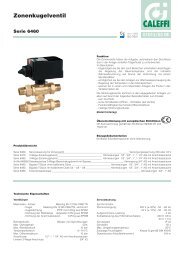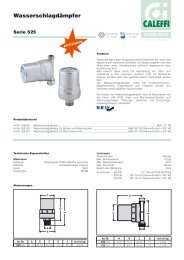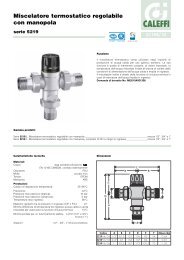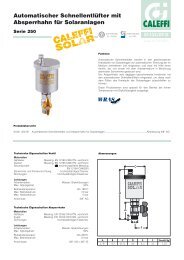Manifolds in composite specifically designed for radiant ... - Caleffi
Manifolds in composite specifically designed for radiant ... - Caleffi
Manifolds in composite specifically designed for radiant ... - Caleffi
Create successful ePaper yourself
Turn your PDF publications into a flip-book with our unique Google optimized e-Paper software.
Hydraulic characteristics<br />
∆P (mm w.g.)<br />
1000<br />
500<br />
200<br />
100<br />
900<br />
800<br />
700<br />
600<br />
450<br />
400<br />
350<br />
300<br />
180<br />
160<br />
140<br />
120<br />
90<br />
80<br />
70<br />
60<br />
50<br />
250<br />
45<br />
40<br />
35<br />
30<br />
20<br />
10<br />
25<br />
18<br />
16<br />
14<br />
12<br />
20<br />
25<br />
30<br />
Example of calculation of total loss of head<br />
Suppos<strong>in</strong>g we need to calculate the loss of head of a manifold with three outlets with the follow<strong>in</strong>g characteristics:<br />
Total manifold flow rate: 350 l/h<br />
The pipes of the three loops have the follow<strong>in</strong>g characteristics of flow rate and loss of head:<br />
Circuit 1 Circuit 2 Circuit 3<br />
∆P1 = 10 kPa ∆P2 = 15 kPa ∆P3 = 7 kPa (1.2)<br />
G1 = 120 l/h G2 = 150 l/h G3 = 80 l/h<br />
We calculate each term of the <strong>for</strong>mula (1.1), us<strong>in</strong>g the relationship:<br />
∆P = G 2 /Kv 0.01 2<br />
35<br />
40<br />
45<br />
50<br />
60<br />
70<br />
80<br />
90<br />
· G = flow rate <strong>in</strong> l/h<br />
· ∆P = loss of head <strong>in</strong> kPa (1 kPa =100 mm w.g.)<br />
· Kv 0,01 = flow rate <strong>in</strong> l/h through the device, which corresponds to a head loss of 1 kPa<br />
It should be stressed that the calculation of ∆PTot. must be made tak<strong>in</strong>g account of the circuit <strong>in</strong> which there are the greatest head losses<br />
distributed along the entire loop of the panel pip<strong>in</strong>g.<br />
In the case we are exam<strong>in</strong><strong>in</strong>g, the relevant circuit is No. 2.<br />
It follows that:<br />
∆PBV = 1502 /1002 = 2,25 kPa<br />
∆PLoop = 15 kPa<br />
∆PSV = 1502 /2402 = 0,39 kPa<br />
∆PF Man. = 3502 /16002 = 0,05 kPa } Values obta<strong>in</strong>ed by disregard<strong>in</strong>g variations due to flow rate to each branch circuit<br />
∆PR Man. = 3502 /16002 = 0,05 kPa<br />
∆PBall V = 3502 /16502 = 0,04 kPa<br />
By means of (1.1) add<strong>in</strong>g up all the calculated terms, we have:<br />
∆PTot.= 2,25 + 15 + 0,39 + 0,05 + 0,05 + 0,04 = 17,64 kPa<br />
100<br />
Flow rate balanc<strong>in</strong>g valve fully open<br />
Shut-off valve<br />
120<br />
140<br />
160<br />
180<br />
- Kv = flow rate <strong>in</strong> m 3 /h <strong>for</strong> a loss of head of 1 bar<br />
- Kv 0,01 = flow rate <strong>in</strong> l/h <strong>for</strong> a loss of head of 1 kPa<br />
200<br />
250<br />
300<br />
350<br />
400<br />
450<br />
Kv<br />
1,00<br />
2,40<br />
500<br />
G (l/h)<br />
∆P (kPa)<br />
Note:<br />
Because of the low head losses <strong>for</strong> the ball valves and the manifolds, the three terms relat<strong>in</strong>g to them can be neglected.<br />
In general, the total head loss is reasonably approximate to that of the branched circuit of the panel.<br />
9<br />
8<br />
7<br />
6<br />
2,5<br />
10<br />
5<br />
4,5<br />
4<br />
3,5<br />
3<br />
2<br />
1,8<br />
1,6<br />
1,4<br />
1,2<br />
1<br />
0,9<br />
0,8<br />
0,7<br />
0,6<br />
0,25<br />
0,5<br />
0,45<br />
0,4<br />
0,35<br />
0,3<br />
0,2<br />
0,18<br />
0,16<br />
0,14<br />
0,12<br />
0,1<br />
Kv 0,01<br />
100<br />
240<br />
∆P (mm w.g.)<br />
1000<br />
500<br />
200<br />
100<br />
900<br />
800<br />
700<br />
600<br />
450<br />
400<br />
350<br />
300<br />
180<br />
160<br />
140<br />
120<br />
90<br />
80<br />
70<br />
60<br />
50<br />
20<br />
10<br />
250<br />
45<br />
40<br />
35<br />
30<br />
25<br />
18<br />
16<br />
14<br />
12<br />
500<br />
600<br />
Flow or return manifold 3÷6 outlets<br />
Flow or return manifold 7÷10 outlets<br />
Ball valve<br />
* Average value<br />
700<br />
800<br />
900<br />
1000<br />
1200<br />
1400<br />
1600<br />
1800<br />
2000<br />
2500<br />
3000<br />
Kv<br />
16,0*<br />
12,0*<br />
16,5*<br />
3500<br />
G (l/h)<br />
∆P (kPa)<br />
4000<br />
9<br />
8<br />
7<br />
6<br />
2,5<br />
10<br />
5<br />
4,5<br />
4<br />
3,5<br />
3<br />
2<br />
1,8<br />
1,6<br />
1,4<br />
1,2<br />
1<br />
0,9<br />
0,8<br />
0,7<br />
0,6<br />
0,25<br />
0,5<br />
0,45<br />
0,4<br />
0,35<br />
0,3<br />
0,2<br />
0,18<br />
0,16<br />
0,14<br />
0,12<br />
0,1<br />
Kv0,01 1600*<br />
1200*<br />
1650*



